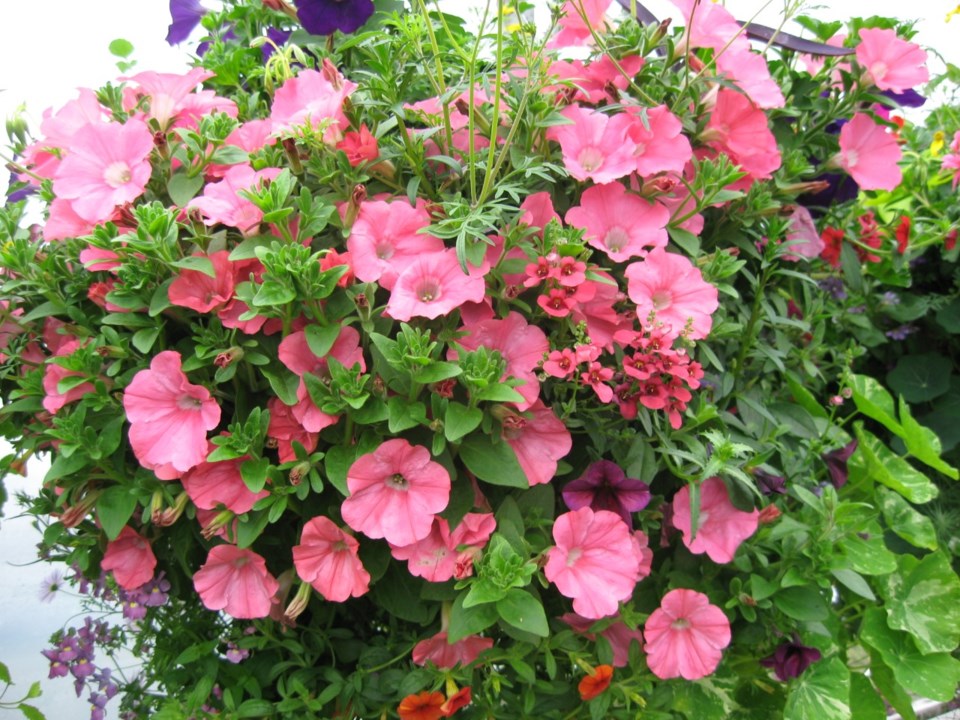The following column was submitted to the Tri-City News from Brian Minter — master gardener, best-selling author, Order of Canada recipient and co-owner of Minter Country Garden Store.
I'll stick my neck out and say that a significant percentage of all the hanging baskets that look good when first put up, often around Mother’s Day, will be somewhat less than gorgeous by early summer.
The problem is that many folks aren’t really sure how to care for them.
They don't realize that a little bit of soil in a small basket, swinging in the wind, needs a lot of help to support a wide variety of plants.
Watering is the most important issue.
The secret is simple: water thoroughly every time you water, but don't water again until the soil is dry.
How do you tell? Feel the weight of the basket by putting your hand underneath and pushing it upward.
If it weighs a ton, hold off on the water.
Once you've learned the art of watering, you've mastered 60 per cent of the technique of growing a good basket.
If you use a hose for watering, try a good watering wand with a soft-rain nozzle. Not only is it easier to reach those difficult areas, but you'll also do a much better job, as this special nozzle prevents soil compaction.
Try to water in the morning when the temperature is on the rise, and make sure the foliage is dry in the evening.
Another key to a spectacular basket is feeding.
Like watering, feeding is an art. In such a small amount of soil, hanging basket plants need copious amounts of food and lots of organic matter.
When you first start out, it's important to get some strong vegetative growth. Fast-acting, soluble, liquid fertilizers, like 20-20-20 or 15-30-15 'Miracle Gro', are ideal. They have lots of the three primary nutrients and a good dose of micro-nutrients as well.
The best time to feed is immediately after watering. Get into the habit of watering first, then feeding right after. During periods of wet, cool weather avoid both watering and feeding for fear of drowning the plants' roots.
As the weather becomes warmer and the soil dries out more quickly, you can increase the frequency of feeding. Despite your best intentions, I would venture to bet that your plants are still going to be hungry. That is why I always supplement all basket feedings with a slow-release fertilizer. There are many formulations, but a well-balanced 14-14-14 fertilizer will work well. One application of two or three tablespoons are all you'll need for continuous feeding the rest of the summer.
It's amazing stuff.
All this fertilization will get those plants moving, but don't forget that you planted those baskets for some colour.
Once your baskets are on their way and really growing, switch to a fertilizer that is low in nitrogen but high in phosphorus and potash. I'm pleased with the results from the fish fertilizer-based formulation of Morbloom 0-10-10. It holds the vegetative growth back while allowing lots of blossoms to form.
The size of your basket, proper watering and the timing and choice of fertilizers are, believe me, the secrets to success with baskets.
Sure, you must dead-head, prune back and occasionally spray for any disease and insect issues, but those three areas are the keys to great looking baskets.
Until your baskets acclimatize to outside conditions, it’s important to keep them out of the wind and in the most sheltered spot you have.
By taking a little extra care, all your baskets and containers should look fabulous and be even bigger and more beautiful as the summer goes on!


